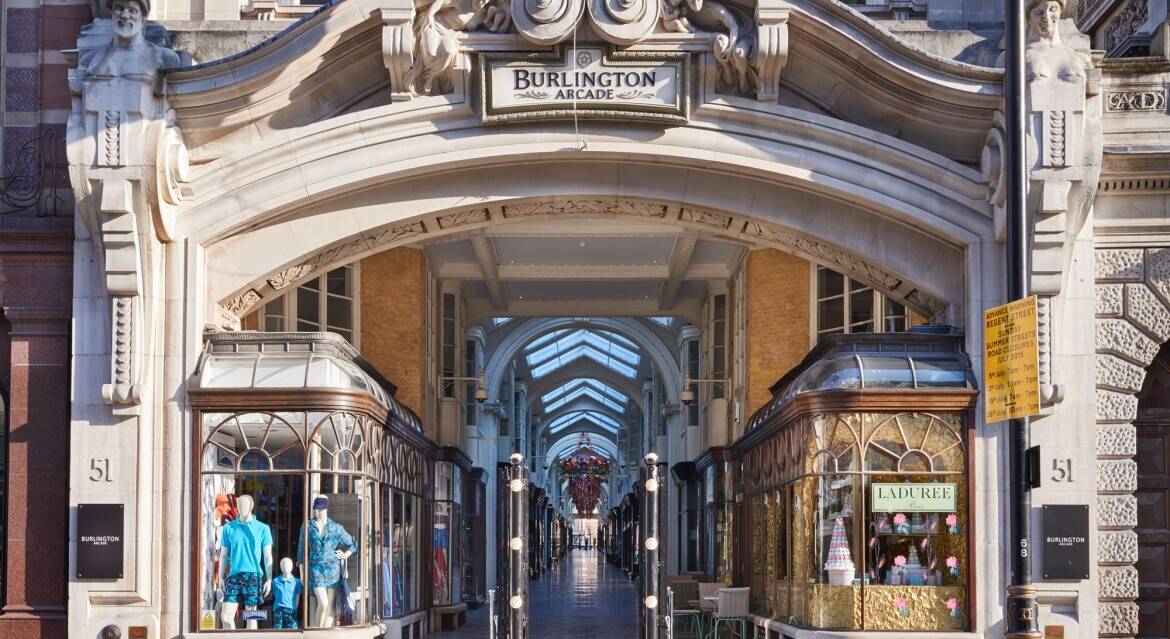
Explore London’s ancient Greek-inspired architectural gems
Back to ItineriesLondon’s West End is famous for its electric nightlife, breath-taking architecture, world-class theatre and its place on the world-class culinary scene.
Right at the very heart of the West End is the Shaftesbury Memorial Fountain, fondly (and wrongly) referred to as ‘Eros’ by Londoners.
Yinka Ilori’s brand new artwork takes inspiration from the winged statue which is actually of Anteros, which sits atop the fountain. In Greek mythology, Anteros is the god of requited love.
.. But did you know the sculptures and architecture of the West End was often inspired by the Greek mythology?
Good Things Come To Those Who Wait
From 20th August, the iconic Piccadilly Circus has transformed into an incredible dreamscape in collaboration with Art of London and British-Nigerian artist and designer Yinka Ilori MBE. Titled ‘Good Things Come To Those Who Wait’, this mesmerising public art installation adorns the Shaftesbury Memorial Fountain for the first time in 132 years.
Drawing inspiration from Greek mythology, as inspired by the sculpture of the mythological Greek god, Anteros - positioned at the top the fountain. Ilori has adorned this historic landmark with two majestic Pegasus figures, each soaring 23 feet high. These grand sculptures stand tall on vibrant orange and yellow plinths, featuring uplifting affirmations that inspire everyone to chase and achieve their dreams.
Anteros
The Shaftesbury Memorial Fountain, located in Piccadilly Circus, London, is famously topped by the iconic statue of Anteros, often mistaken for his brother Eros. Anteros, the Greek god of selfless love, was chosen to honour the philanthropic works of Lord Shaftesbury.
The elegant statue, crafted from aluminium, symbolises the spirit of charity and altruism, reflecting Shaftesbury's commitment to social reform. As one of London's most recognisable landmarks, it continues to be a popular meeting point and a symbol of the city's heart.
The Horses of Helios
At the corner of Piccadilly and Haymarket, near 1 Jermyn Street and adjacent to the Criterion Theatre, stands the impressive ‘Horses of Helios’ sculpture.
This stunning bronze artwork created by Rudy Weller and unveiled in 1992, captures the power and energy of Greek mythology. Four mighty horses—Aethon, Eous, Phlegon, and Pyrois—seem to explode from the fountain's waters, symbolising the fiery steeds of Helios, the ancient Greek god of the sun.
In Greek mythology, Helios is said to be the Greek god of the sun who at dawn and dusk each day, drives a chariot across the sky led by his four horses which was said to make the sun rise and set.
The ‘Horses of Helios’ sculpture is made up of three bronze pieces with a dark finish which creates create a powerful tribute to the ancient legend of Helios.
The Three Graces
High atop the Criterion Building, the elegant figures known as ‘The Three Daughters of Helios’, or ‘The Three Graces,’ make a celestial leap.
This sculpture represents Aglaea, Euphrosyne, and Thalia—the three Charities , daughters of Helios and the naiad nymph Aegle. Crafted from gold-leaf-covered aluminium, these radiant figures seem to defy gravity as they leap from the 6th floor, on the building adjacent topowerful ‘Horses of Helios.’
This hidden gem in the sky offers a touch of divine beauty, which can only be spotted when passersby look up from Haidilao Hot Pot (opposite side of the road).
Burlington Arcade
Nestled between Bond Street and Piccadilly, Burlington Arcade, established in 1819, is one of London’s most elegant shopping arcades, renowned for its Regency charm and luxury boutiques. This historic arcade also carries a whisper of inspiration from Greek mythology through its intricate architectural details.
As you enter the arcade, look up to see a detailed pedimental sculpture by Benjamin Clemens. It features graceful figures of women and children, with a prominent helmeted male figure on the left reminiscent of ancient Greek statues, adding a classical ancient touch to complement the arcade’s elegant design.
St. Martin-in-the-Fields Church
Located at the edge of Trafalgar Square, St. Martin-in-the-Fields Church is famous for its elegant architecture, which, while focused on Christian themes, also showcases classical influences reminiscent of Greek and Roman styles. Designed by architect James Gibbs and completed in 1726, the church features classical elements such as columns and pediments that reflect the grandeur of ancient architecture.
Designed by architect James Gibbs and finished in 1726, the church boasts classic features like tall columns and a grand pediment. The front of the church is highlighted by a stunning portico with Corinthian columns and a striking pediment above the entrance.






